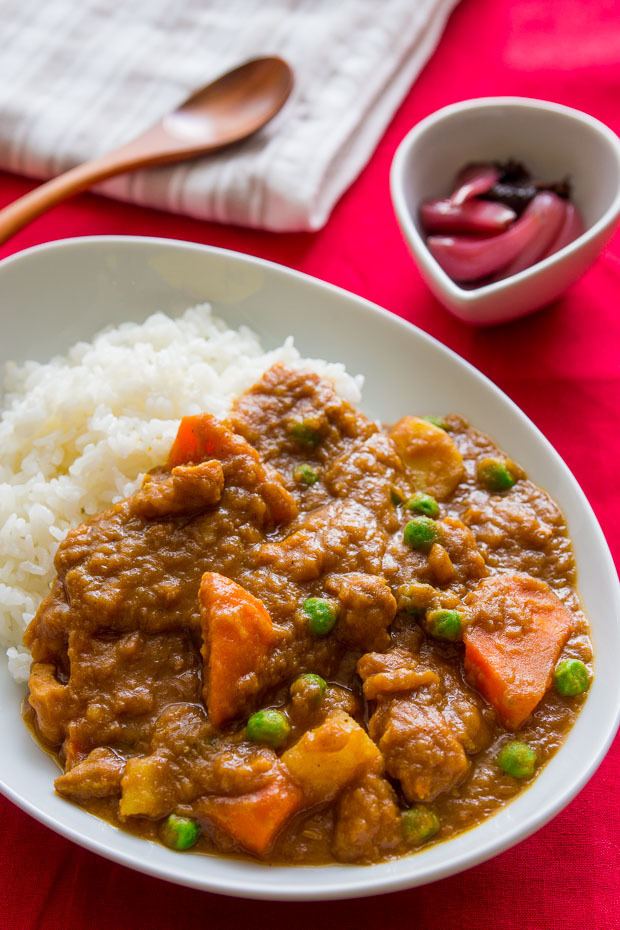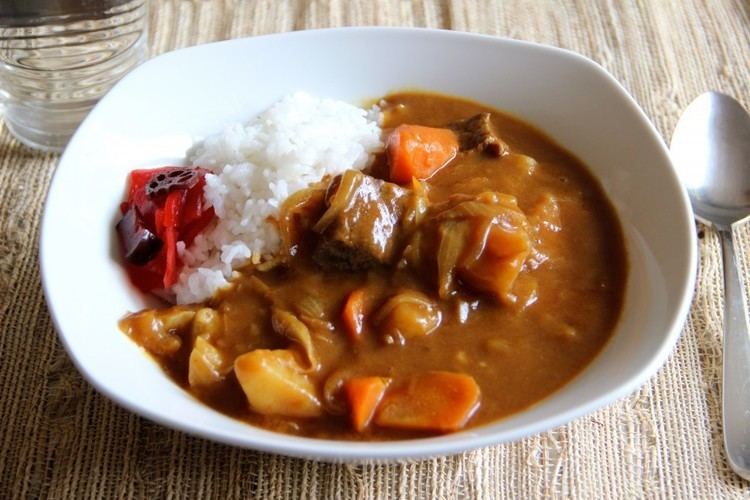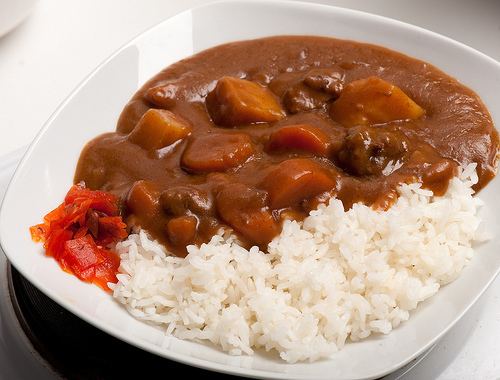Place of origin Japan | ||
 | ||
Similar Curry, Tonkatsu, Udon, Donburi, Ramen | ||
Curry (カレー, karē) is one of the most popular dishes in Japan. It is commonly served in three main forms: curry rice (カレーライス, karē raisu, curry over rice), curry udon (curry over noodles), and curry bread (a curry-filled pastry). Curry rice is most commonly referred to simply as "curry" (カレー, karē).
Contents
- How to make japanese curry katsu curry
- Overview
- Sauce mixes
- Sides
- Other varieties
- Local curries
- Events
- South Korea
- North Korea
- Elsewhere
- Serving
- References
A wide variety of vegetables and meats are used to make Japanese curry. The basic vegetables are onions, carrots, and potatoes. For the meat, beef, pork, and chicken are the most popular. Katsu-karē is a breaded deep-fried cutlet (usually pork or chicken) with curry sauce.

Curry was introduced to Japan during the Meiji era (1868–1912) by the British, at a time when India was under the colonial rule of the British Raj. The dish became popular and available for purchase in supermarkets and restaurants in the late 1960s. It has been adapted since its introduction to Japan, and is so widely consumed that it can be called a national dish.

How to make japanese curry katsu curry
Overview

As curry was introduced to Japan via British cuisine, it was originally considered to be Western cuisine. This Western-style curry co-exists alongside Indian-style curry, which has become popular since the increase in Indian restaurants in the 1990s. Western-style curry is influenced by stews mixed with curry powder, which were popular amongst the British Navy. The Imperial Japanese Navy adopted curry from the Royal Navy to prevent beriberi, and now the Japan Maritime Self-Defense Force's Friday menu is curry.
Sauce mixes

Curry sauce (カレーソース, karē sōsu) is served on top of cooked rice to make curry rice. Curry sauce is made by frying together curry powder, flour, and oil, along with other ingredients, to make roux; the roux is then added to stewed meat and vegetables, and then simmered until thickened. Adding potatoes to curry sauce was introduced by William S. Clark of the Sapporo Agricultural College, due to rice shortages at the time.

In Japanese homes, curry sauce is most commonly made from instant curry roux, which is available in block and powder forms, and contains curry powder, flour, oils and various flavourings. Ease of preparation, and the wide variety and availability of instant curry mixes, has made curry rice very popular, as it is very easy to make compared to many other Japanese dishes. Pre-made curry is available in vacuum-sealed bags that can be reheated in boiling water.
Instant curry roux was first sold in powder form by House Foods in 1926, and in block form by S&B Foods in 1956. In 2007, Japanese domestic shipments of instant curry roux was 82.7 billion yen. Market share for household use in 2007 was captured almost entirely by House Foods (59.0%), S&B Foods (25.8%) and Ezaki Glico (9.4%).
Vacuum-sealed curry sauce, prepared by heating the retort pouch in hot water or the microwave, is also popular. As of financial 2007, curry sauce is the largest single category of vacuum-sealed foods in Japan, making up over 30% of sales.
Sides
Curry rice is usually served with fukujinzuke or rakkyō on the side.
Other varieties
Local curries
In the late 1990s, a number of regional specialty curries emerged, popularised as vacuum-sealed curry sauces. These include:
Local curries are also being marketed to help boost tourism. Some varieties of this include Yokosuka navy curry (よこすか海軍カレー, Yokosuka kaigun karē), sold in Yokosuka to promote its heritage as a naval base, and Zeppelin Curry (ツェッペリンカレー, Tsepperin Karē) in Tsuchiura to promote the Zeppelin landing in 1929.
Events
Every year on 25 September, the Matsumotoro Restaurant (松本楼) in Hibiya Park holds a famous 10-yen curry buffet for charity, to commemorate the re-opening of the restaurant in 1973 after it was burnt down during demonstrations in 1971 against the return of Okinawa to Japan by the United States.
South Korea
Curry was introduced to South Korea during the period of Japanese rule, and is popular there. It is often found at bunsik restaurants (diner-style establishments), donkkaseu-oriented restaurants, and at the majority of Japanese restaurants. Premade curry and powdered mixes are also readily available in supermarkets.
North Korea
Japanese-style curry was introduced to North Korea by Koreans and Japanese who migrated from Japan to North Korea during the 1960s-1970s repatriation project. Along with other Japanese cuisine, it was traded by new arrivals for local products and used to bribe Worker's Party cadres.
Elsewhere
Mixes can be found outside Japan and Korea in supermarkets that have a Japanese section or in Japanese or Asian food stores.
The largest Japanese curry company in Japan is House Foods Corporation. The company operates more than 10 Curry House Restaurants in the USA. Its associated company CoCo Ichibanya (Ichibanya Co., Ltd.) or Kokoichi has more than 1,200 restaurants in Japan. CoCo Ichibanya has branches in Hawaii (USA), California (USA), China, Hong Kong, Taiwan, Korea, Singapore, Indonesia, Philippines and Thailand.
Serving
Japanese curry rice is served in anything from a flat plate to a soup bowl. The curry is poured over rice in any manner and amount. Japanese short grain rice, which is sticky and round, is preferred, rather than the medium grain variety used in Indian and Chinese dishes. It is usually eaten with a spoon, as opposed to chopsticks, because of the liquid nature of the curry, and is usually served garnished with vegetables pickled in vinegar such as fukujinzuke or rakkyo.
